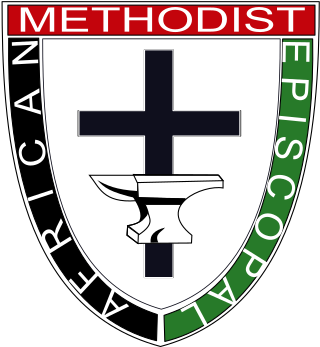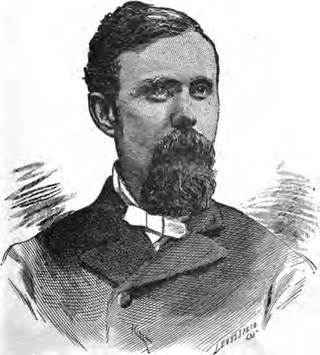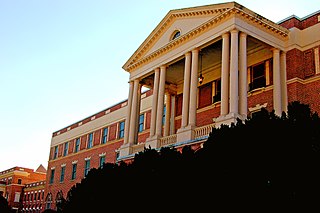
Wilberforce University is a private historically black university in Wilberforce, Ohio. Affiliated with the African Methodist Episcopal Church (AME), it was the first college to be owned and operated by African Americans. It participates in the United Negro College Fund.
The Methodist Episcopal Church, South was the American Methodist denomination resulting from the 19th-century split over the issue of slavery in the Methodist Episcopal Church (MEC). Disagreement on this issue had been increasing in strength for decades between churches of the Northern and Southern United States; in 1845 it resulted in a schism at the General Conference of the MEC held in Louisville, Kentucky.

The African Methodist Episcopal Church, usually called the AME Church or AME, is a Methodist denomination based in the United States. It adheres to Wesleyan-Arminian theology and has a connexional polity. It cooperates with other Methodist bodies through the World Methodist Council and Wesleyan Holiness Connection.

Jonathan Myrick Daniels was an Episcopal seminarian and civil rights activist. In 1965, he was killed by Tom Coleman, a highway worker and part-time deputy sheriff, in Hayneville, Alabama, while in the act of shielding 17-year-old Ruby Sales from a racist attack. He saved the life of the young Black civil rights activist. They were both working in the nonviolent civil rights movement in Lowndes County to integrate public places and register Black voters after passage of the Voting Rights Act that summer. Daniels' death generated further support for the civil rights movement.

Robert Kennon Hargrove (1829–1905) was an American bishop of the Methodist Episcopal Church, South, elected in 1882.

The original campus of Centenary College of Louisiana is located along College Street in Jackson, Louisiana. It is operated and preserved as a museum by the Louisiana Office of State Parks as the Centenary State Historic Site, offering educational interpretive programs and guided tours.
The Genesee Wesleyan Seminary was the name of two institutions located on the same site in Lima, New York.

Daniel Payne College, also known as the Payne Institute, Payne University and Greater Payne University, was a historically black college in Birmingham, Alabama from 1889 to 1979. It was associated with the African Methodist Episcopal Church. The college was named in honor of Daniel Payne, the sixth bishop of the AME Church and the first black president of a college in the United States.
A comprehensive regional university today, the University of North Alabama traces its beginnings to the first half of the 19th century, when the Methodist Episcopal Church sought to bring learning and culture to an obscure mountain in Alabama.
Summerfield, also known as Valley Creek, is an unincorporated community in Dallas County, Alabama. Summerfield has one historic district included on the National Register of Historic Places, the Summerfield District. Most of the community was annexed into Valley Grande following its incorporation as a city in 2003. Summerfield was the home of the Centenary Institute, a school operated by the Methodist Episcopal Church, South, from 1829 until the 1880s.
Octagon is an unincorporated community in Marengo County, Alabama, United States. Octagon had a post office at one time, but it no longer exists.

State Street African Methodist Episcopal Zion Church is a historic African American church in Mobile, Alabama. It is the oldest documented Methodist church building in Alabama. It is also one of two African American churches founded in the Methodist tradition in Mobile prior to the American Civil War.

Thomas Van Scoy was an American minister and educator in Indiana, Oregon, and Montana. A Methodist, he served as the sixth president of Willamette University and as president of the now defunct Portland University. He was also president of Montana Wesleyan University and served in the militia at the end of the American Civil War.

Blackstone College for Girls was a private, religious school for young women in Blackstone, Nottoway County, in the U.S. state of Virginia. The school operated under the auspices of the Virginia Conference of the Methodist Episcopal Church, South between 1894 and 1950. The Virginia Department of Historic Resources acknowledged the significance of the site by erecting historical marker number K 174 in 1996. Blackstone College is also designated as a site on the Civil Rights in Education Heritage Trail. The school buildings still stand. Since 1955, the Virginia United Methodist Church has used the former school buildings as a conference center.
The civil rights movement (1865–1896) aimed to eliminate racial discrimination against African Americans, improve their educational and employment opportunities, and establish their electoral power, just after the abolition of slavery in the United States. The period from 1865 to 1895 saw a tremendous change in the fortunes of the Black community following the elimination of slavery in the South.
West Presbyterian Church was a congregation and two houses of worship in Manhattan, New York City. The congregation was founded in 1829 and merged in 1911 with Park Presbyterian Church to form West-Park Presbyterian Church. The first house of worship, also known as the Carmine Street Presbyterian Church, in Greenwich Village, was used from 1832 to 1865, and the second, on West 42nd Street between Fifth Avenue and Sixth Avenue, from 1865 until 1911, when it was sold and demolished. Proceeds from the sale were used, in accordance with the merger agreement, to build and endow a church for an underserved neighborhood, Washington Heights: Fort Washington Presbyterian Church. In addition, the West Church congregation had earlier established two mission churches which eventually merged to become Good Shepherd-Faith Presbyterian Church. West-Park, Fort Washington, and Good Shepherd-Faith are all active today.
Madison College was an educational institution in Uniontown, Pennsylvania, operated by the Methodist Episcopal Church. The college was chartered by the Pennsylvania legislature in 1827, and it was operated by the Methodist Episcopal Church until 1832, after which it became associated with the Cumberland Presbyterian Church. Andrew Stewart was instrumental in its physical construction.

Central Alabama Institute was a private school for African American in Alabama, United States. The school was the city of Huntsville's first school for the African American community during the Reconstruction era. It was founded in 1865 in Huntsville, Alabama, and moved in 1904 to Mason City, near Birmingham, Alabama. The school also went by the names Rust Institute, Rust Normal Institute, Rust Biblical and Normal Institute, Central Alabama Academy, Central Alabama Institute and College, and Central Alabama College.
Haygood Seminary, also known as Haygood Academy, was a seminary near Washington, Arkansas, United States. It was established by the Colored Methodist Episcopal Church to train African Americans in Arkansas for a career in the clergy. It was one of the first such institutions established by the CME Church. In 1927, the school relocated to Jefferson County, Arkansas, where it operated as Arkansas-Haygood Industrial College before closing during World War II.

Alabama Female Institute was one of the earliest educational institutions for women organized in Alabama. It opened in Tuscaloosa, in the fall of 1829, as "Sims' Female Academy". In 1831, it became the "Tuscaloosa Female Academy". The name change to Alabama Female Institute occurred in 1833, and this school was chartered in 1835. It continued to operate until 1873.











